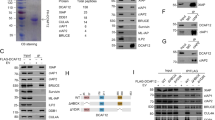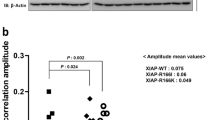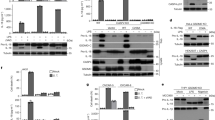Abstract
Direct IAP binding protein with low pI/second mitochondrial activator of caspases, HtrA2/Omi and GstPT/eRF3 are mammalian proteins that bind via N-terminal inhibitor of apoptosis protein (IAP) binding motifs (IBMs) to the baculoviral IAP repeat (BIR) domains of IAPs. These interactions can prevent IAPs from inhibiting caspases, or displace active caspases, thereby promoting cell death. We have identified several additional potential IAP antagonists, including glutamate dehydrogenase (GdH), Nipsnap 3 and 4, CLPX, leucine-rich pentatricopeptide repeat motif-containing protein and 3-hydroxyisobutyrate dehydrogenase. All are mitochondrial proteins from which N-terminal import sequences are removed generating N-terminal IBMs. Whereas most of these proteins have alanine at the N-terminal position, as observed for previously described antagonists, GdH has an N-terminal serine residue that is essential for X-linked IAP (XIAP) interaction. These newly described IAP binding proteins interact with XIAP mainly via BIR2, with binding eliminated or significantly reduced by a single point mutation (D214S) within this domain. Through this interaction, many are able to antagonise XIAP inhibition of caspase 3 in vitro.
Similar content being viewed by others
Log in or create a free account to read this content
Gain free access to this article, as well as selected content from this journal and more on nature.com
or
Accession codes
Abbreviations
- IAP:
-
inhibitor of apoptosis
- BIR:
-
baculoviral IAP repeat
- Diablo:
-
direct IAP binding protein with low pI
- Smac:
-
second mitochondrial activator of caspases
- GdH:
-
glutamate dehydrogenase
- LRPPR:
-
leucine-rich pentatricopeptide repeat motif-containing protein
- 3HB:
-
3 hydroxyisobutyrate dehydrogenase
- Nsp:
-
Nipsnap
- IBM:
-
IAP binding motif
References
Verhagen AM, Coulson EJ, Vaux DL . Inhibitor of apoptosis proteins and their relatives: IAPs and other BIRPs. Genome Biol 2001; 2: 3009.1–3009.10.
Gerl RE, Verhagen AM . IAPs, their antagonists and their role in neurological disease and cancer. Curr Med Chem – Anti-Inflamm Anti-Allergy Agent 2005; 4: 393–406.
Vaux DL, Silke J . IAPs, RINGs and ubiquitylation. Nat Rev Mol Cell Biol 2005; 6: 287–297.
Liu ZH, Sun CH, Olejniczak ET, Meadows RP, Betz SF, Oost T et al. Structural basis for binding of Smac/DIABLO to the XIAP BIR3 domain. Nature 2000; 408: 1004–1008.
Wu G, Chai JJ, Suber TL, Wu JW, Du CY, Wang XD et al. Structural basis of IAP recognition by Smac/DIABLO. Nature 2000; 408: 1008–1012.
Shin H, Renatus M, Eckelman BP, Nunes VA, Sampaio CA, Salvesen GS . The BIR domain of IAP-like protein 2 is conformationally unstable: implications for caspase inhibition. Biochem J 2005; 385: 1–10.
Vucic D, Franklin MC, Wallweber HJ, Das K, Eckelman BP, Shin H et al. Engineering ML-IAP to produce an extraordinarily potent caspase 9 inhibitor: implications for Smac-dependent anti-apoptotic activity of ML-IAP. Biochem J 2005; 385: 11–20.
Wilkinson JC, Wilkinson AS, Scott FL, Csomos RA, Salvesen GS, Duckett CS . Neutralization of Smac/Diablo by inhibitors of apoptosis (IAPs). A caspase-independent mechanism for apoptotic inhibition. J Biol Chem 2004; 279: 51082–51090.
Silke J, Hawkins CJ, Ekert PG, Chew J, Day CL, Pakusch M et al. The anti-apoptotic activity of XIAP is retained upon mutation of both the caspase 3- and caspase 9-interacting sites. J Cell Biol 2002; 157: 115–124.
Verhagen AM, Ekert PG, Pakusch M, Silke J, Connolly LM, Reid GE et al. Identification of DIABLO, a mammalian protein that promotes apoptosis by binding to and antagonizing IAP proteins. Cell 2000; 102: 42–53.
Du C, Fang M, Li Y, Li L, Wang X . Smac, a mitochondrial protein that promotes cytochrome c-dependent caspase activation by eliminating IAP inhibition. Cell 2000; 102: 33–42.
Suzuki Y, Imai Y, Nakayama H, Takahashi K, Takio K, Takahashi R . A serine protease, HtrA2, is released from the mitochondria and interacts with XIAP, inducing cell death. Mol Cell 2001; 8: 613–621.
Hegde R, Srinivasula SM, Zhang Z, Wassell R, Mukattash R, Cilenti L et al. Identification of Omi/HtrA2 as a mitochondrial apoptotic serine protease that disrupts inhibitor of apoptosis protein–caspase interaction. J Biol Chem 2001; 277: 432–438.
Martins LM, Iaccarino I, Tenev T, Gschmeissner S, Totty NF, Lemoine NR et al. The serine protease Omi/HtrA2 regulates apoptosis by binding XIAP through a reaper-like motif. J Biol Chem 2001; 277: 439–444.
Verhagen AM, Silke J, Ekert PG, Pakusch M, Kaufmann H, Connolly LM et al. HtrA2 promotes cell death through its serine protease activity and its ability to antagonize inhibitor of apoptosis proteins. J Biol Chem 2002; 277: 445–454.
Hegde R, Srinivasula SM, Datta P, Madesh M, Wassell R, Zhang Z et al. The polypeptide chain-releasing factor GSPT1/eRF3 is proteolytically processed into an IAP-binding protein. J Biol Chem 2003; 278: 38699–38706.
Jin S, Kalkum M, Overholtzer M, Stoffel A, Chait BT, Levine AJ . CIAP1 and the serine protease HTRA2 are involved in a novel p53-dependent apoptosis pathway in mammals. Genes Dev 2003; 17: 359–367.
Burri L, Strahm Y, Hawkins CJ, Gentle IE, Puryer MA, Verhagen A et al. Mature DIABLO/Smac is produced by the IMP protease complex on the mitochondrial inner membrane. Mol Biol Cell 2005; 16: 2926–2933.
Van Loo G, Demol H, van Gurp M, Hoorelbeke B, Schotte P, Beyaert R et al. A matrix-assisted laser desorption ionization post-source decay (MALDI- PSD) analysis of proteins released from isolated liver mitochondria treated with recombinant truncated Bid. Cell Death Differ 2002; 9: 301–308.
Rothe M, Pan MG, Henzel WJ, Ayres TM, Goeddel DV . The TNF-R2–TRAF signaling complex contains two novel proteins related to baculoviral-inhibitor of apoptosis proteins. Cell 1995; 83: 1243–1252.
Lee AH, Zareei MP, Daefler S . Identification of a NIPSNAP homologue as host cell target for Salmonella virulence protein SpiC. Cell Microbiol 2002; 4: 739–750.
Buechler C, Bodzioch M, Bared SM, Sigruener A, Boettcher A, Lapicka-Bodzioch K et al. Expression pattern and raft association of NIPSNAP3 and NIPSNAP4, highly homologous proteins encoded by genes in close proximity to the ATP-binding cassette transporter A1. Genomics 2004; 83: 1116–1124.
Kang SG, Dimitrova MN, Ortega J, Ginsburg A, Maurizi MR . Human mitochondrial ClpP is a stable heptamer that assembles into a tetradecamer in the presence of ClpX. J Biol Chem 2005; 280: 35424–35432.
Mootha VK, Lepage P, Miller K, Bunkenborg J, Reich M, Hjerrild M et al. Identification of a gene causing human cytochrome c oxidase deficiency by integrative genomics. Proc Natl Acad Sci USA 2003; 100: 605–610.
Tanaka T, Soriano MA, Grusby MJ . SLIM is a nuclear ubiquitin E3 ligase that negatively regulates STAT signaling. Immunity 2005; 22: 729–736.
Scott FL, Denault JB, Riedl SJ, Shin H, Renatus M, Salvesen GS . XIAP inhibits caspase-3 and -7 using two binding sites: evolutionarily conserved mechanism of IAPs. EMBO J 2005; 24: 645–655.
Franklin MC, Kadkhodayan S, Ackerly H, Alexandru D, Distefano MD, Elliott LO et al. Structure and function analysis of peptide antagonists of melanoma inhibitor of apoptosis (ML-IAP). Biochemistry 2003; 42: 8223–8231.
Sutton VR, Wowk ME, Cancilla M, Trapani JA . Caspase activation by granzyme B is indirect, and caspase autoprocessing requires the release of proapoptotic mitochondrial factors. Immunity 2003; 18: 319–329.
Goping IS, Barry M, Liston P, Sawchuk T, Constantinescu G, Michalak KM et al. Granzyme B-induced apoptosis requires both direct caspase activation and relief of caspase inhibition. Immunity 2003; 18: 355–365.
Chai J, Du C, Wu JW, Kyin S, Wang X, Shi Y . Structural and biochemical basis of apoptotic activation by Smac/DIABLO. Nature 2000; 406: 855–862.
Wu JW, Cocina AE, Chai J, Hay BA, Shi Y . Structural analysis of a functional DIAP1 fragment bound to grim and hid peptides. Mol Cell 2001; 8: 95–104.
Zachariou A, Tenev T, Goyal L, Agapite J, Steller H, Meier P . IAP-antagonists exhibit non-redundant modes of action through differential DIAP1 binding. EMBO J 2003; 22: 6642–6652.
Lisi S, Mazzon I, White K . Diverse domains of THREAD/DIAP1 are required to inhibit apoptosis induced by REAPER and HID in Drosophila[in process citation]. Genetics 2000; 154: 669–678.
Goyal L, McCall K, Agapite J, Hartwieg E, Steller H . Induction of apoptosis by Drosophila Reaper, Hid and Grim through inhibition of IAP function. EMBO J 2000; 19: 589–597.
Silke J, Kratina T, Chu D, Ekert PG, Day CL, Pakusch M et al. Determination of cell survival by RING-mediated regulation of inhibitor of apoptosis (IAP) protein abundance. Proc Natl Acad Sci USA 2005; 102: 16182–16187.
Jones JM, Datta P, Srinivasula SM, Ji W, Gupta S, Zhang Z et al. Loss of Omi mitochondrial protease activity causes the neuromuscular disorder of mnd2 mutant mice. Nature 2003; 425: 721–727.
Okada H, Suh W-K, Jin J, Woo M, Du C, Elia A et al. Generation and characterization of Smac/DIABLO-deficient mice. Mol Cell Biol 2002; 22: 3509–3517.
Martins LM, Morrison A, Klupsch K, Fedele V, Moisoi N, Teismann P et al. Neuroprotective role of the Reaper-related serine protease HtrA2/Omi revealed by targeted deletion in mice. Mol Cell Biol 2004; 24: 9848–9862.
Ekert PG, Silke J, Hawkins CJ, Verhagen AM, Vaux DL . DIABLO promotes apoptosis by removing MIHA/XIAP from processed caspase 9. J Cell Biol 2001; 152: 483–490.
Silke J, Kratina T, Ekert PG, Pakusch M, Vaux DL . Unlike Diablo/smac, Grim promotes global ubiquitination and specific degradation of X chromosome-linked inhibitor of apoptosis (XIAP) and neither cause apoptosis. J Biol Chem 2004; 279: 4313–4321.
Acknowledgements
We acknowledge Lisa Connolly, Andrew Clippingdale and Robert Moritz from the Joint Protein Service Facility for their mass spectrometric analysis, Diep Chu for recombinant Diablo protein and David Huang for vectors provided. AMV is a recipient of an Australian Research Council (ARC) QEII fellowship. DLV is an National Health and Medical Research (NHMRC) Senior Principle Research Fellow. PGE, JS and CJH are all supported by NHMRC Career Development fellowships. This work was supported by NHMRC Program Grant (257502) and a Leukemia and Lymphoma Society Center Grant. CH's work is supported by grants from the ARC (#DP0343431) and NHMRC (#284513).
Author information
Authors and Affiliations
Corresponding author
Additional information
Edited by G Melino
Rights and permissions
About this article
Cite this article
Verhagen, A., Kratina, T., Hawkins, C. et al. Identification of mammalian mitochondrial proteins that interact with IAPs via N-terminal IAP binding motifs. Cell Death Differ 14, 348–357 (2007). https://doi.org/10.1038/sj.cdd.4402001
Received:
Revised:
Accepted:
Published:
Issue date:
DOI: https://doi.org/10.1038/sj.cdd.4402001
Keywords
This article is cited by
-
Targeting multifunctional magnetic nanowires for drug delivery in cancer cell death: an emerging paradigm
Environmental Science and Pollution Research (2023)
-
Combination of IAP antagonist and IFNγ activates novel caspase-10- and RIPK1-dependent cell death pathways
Cell Death & Differentiation (2017)
-
Inhibitors of apoptosis: clinical implications in cancer
Apoptosis (2017)
-
Mitochondrial permeabilization engages NF-κB-dependent anti-tumour activity under caspase deficiency
Nature Cell Biology (2017)
-
Glaucoma related Proteomic Alterations in Human Retina Samples
Scientific Reports (2016)



